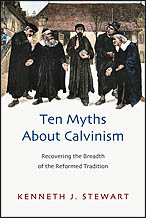 Kenneth J. Stewart, Ten Myths About Calvinism: Recovering the Breadth of the Reformed Tradition (Downers Grove, IL: IVP Academic, 2011). $24.00, 302 pages.
Kenneth J. Stewart, Ten Myths About Calvinism: Recovering the Breadth of the Reformed Tradition (Downers Grove, IL: IVP Academic, 2011). $24.00, 302 pages.
In Ten Myths About Calvinism, Kenneth J. Stewart skillfully dissects misinformation—sometimes, frankly, disinformation—commonly circulated about Calvinist theology and culture. (Stewart’s preferred term is Reformed, not Calvinist, although he uses the terms interchangeably. Indeed, this is the preference of most Calvinists.)
Calvinist partisans perpetuate the first four myths:
- One man (Calvin) and one city (Geneva) are determinative (21–43)
- Calvin’s view of predestination must be ours (45–72)
- TULIP is the yardstick of the truly Reformed (75–96)
- Calvinists take a dim view of revival and awakening (99–120)
Anti-Calvinist partisans perpetuate the remaining six myths:
- Calvinism is largely antimissionary (123–148)
- Calvinism promotes antinomianism (152–170)
- Calvinism leads to theocracy (174–195)
- Calvinism undermines the creative arts (197–217)
- Calvinism resists gender equality (219–245)
- Calvinism has fostered inequality (247–269)
Though I am an Arminian—that is, someone who disputes various points of Calvinist theology—I found this book quite useful for exploring the breadth of the Calvinist movement. The chapter on TULIP was especially helpful. This acrostic is one way of summarizing the response of the Synod of Dordt to the Arminian Remonstrants, but it is not the only way. Nor is Dordtian orthodoxy the only way of framing a Calvinist soteriology.
I appreciated Stewart’s timely reminder of the revivalist and missionary strands of Calvinism, strands that sometimes cooperated with Arminians in the dissemination of the one gospel to which both –isms pledged allegiance. Think of the personal friendship and co-labor of George Whitefield and the Wesley brothers, in this regard. Or think of the evangelical spirituality that both Charles Wesley’s “O For a Thousand Tongues” and Augustus Toplady’s “Rock of Ages” expressed, despite the sharp theological disagreements of their respective authors.
I also appreciated Stewart’s carefully nuanced take on the failings of various Calvinist movements—such as its association with gender and racial inequality. Sure, Calvin did not promote the ordination of women in Geneva, but what theological movement did at that point in time? And sure, Afrikaaners—Dutch Reformed by religious background—promoted apartheid in Africa, but they were opposed by others in the international Reformed movement. Stewart is surely right that “association” with such discreditable practices does not entail “causation.” (Then again, the most vociferous opposition to women’s ordination in America today comes from self-consciously Calvinist authors such as John Piper, but perhaps their Calvinism is detachable from their complementarianism.)
Stewart scores palpable hits against Calvinist and anti-Calvinist mythmakers by complexifying simplistic (mis)interpretations of a movement that is approaching its 500th Anniversary. Though an Arminian, I highly recommend this book to Calvinist and anti-Calvinist readers alike. In the process of seeing myths debunked, you will learn much about a strand of Christianity that continues to find fresh expositions, such as the “New Calvinism” that Collin Hansen so ably described in Young, Restless, Reformed.
P.S. If you found this review helpful, please vote “Yes” on my Amazon.com review page.


George:
Thank you for a fair, even-handed review.
Ken Stewart
You’re welcome, Ken. Thanks for the excellent book!